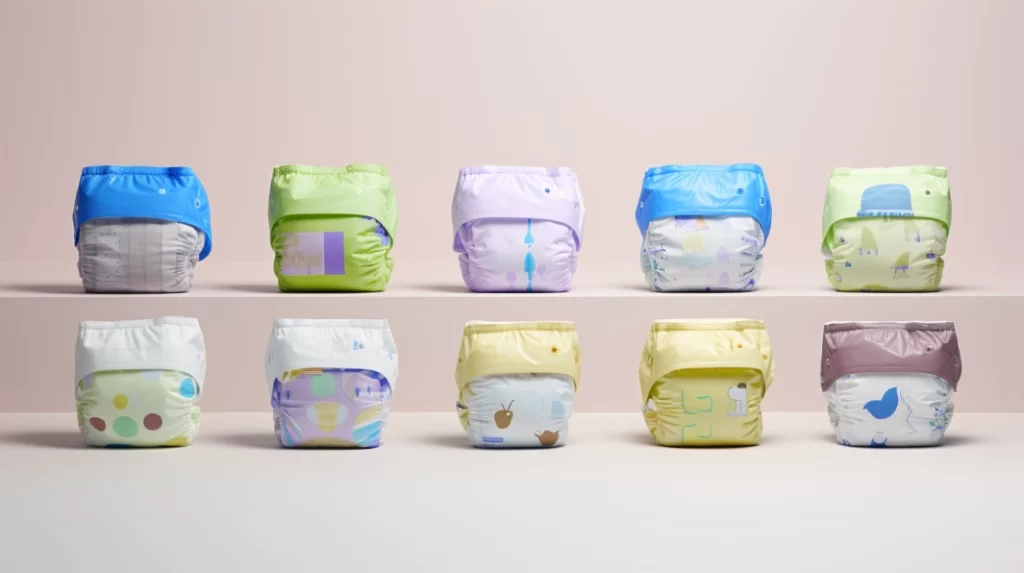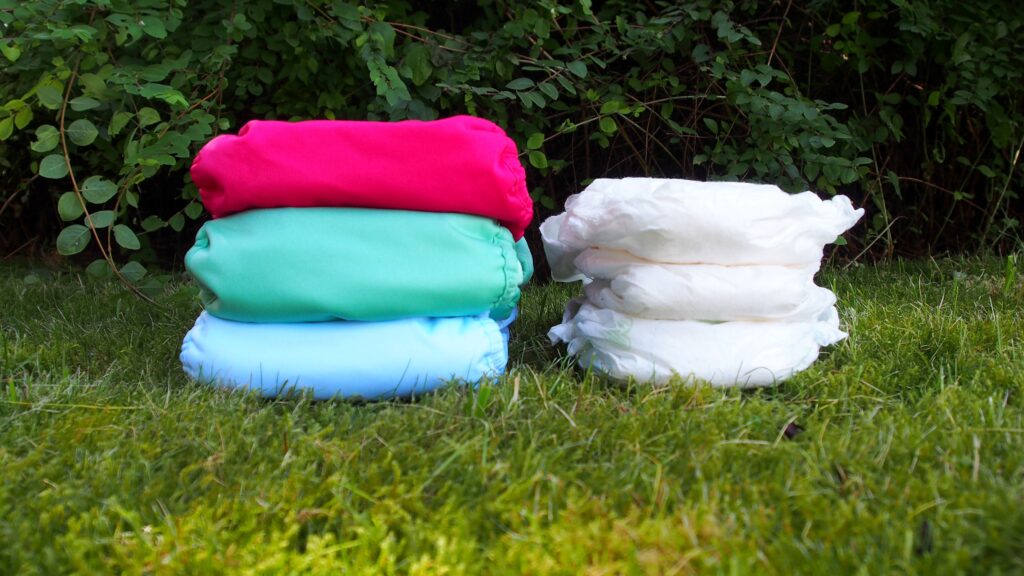Disposable nappies have revolutionized the way parents approach diaper changing, offering convenience and ease of use. However, as with any product, there are pros and cons to consider.
While disposable nappies provide a quick and hassle-free solution for busy parents, they come with a hefty price tag and contribute to environmental waste. Additionally, the chemicals and fragrances used in these nappies may pose potential health risks for babies.
In this article, we will delve into the various aspects of disposable nappies, exploring their advantages, disadvantages, and the impact they have on both our wallets and the environment. By the end, you will have a comprehensive understanding of the trade-offs involved in choosing disposable nappies for your little one.
Key Takeaways
- Disposable diapers offer convenience and a quick diaper-changing process, making them ideal for parents with busy schedules.
- They can help reduce the development of skin rashes and irritation in babies.
- However, disposable diapers are costly, contribute to environmental waste, and may contain plastics and dyes that can cause rashes.
- To use disposable diapers safely, it’s important to change them immediately, maintain a clean diaper-changing area, and wash your baby’s hands after each change.

Disposable Nappies Meaning
Disposable nappies, also known as disposable diapers, are single-use baby products that are designed to be convenient and easy to use. They are made to be worn once and then thrown away, eliminating the need for cleaning and washing. Disposable nappies offer a quick and convenient diaper-changing process, making them ideal for parents with limited time and busy schedules. They are readily available in stores and come in a variety of sizes to fit babies of different ages and weights.
However, there are some drawbacks to using disposable nappies. They can be costly, as the average baby can use up to 2,700 diapers per year. This can add up to a significant expense over time. Additionally, disposable nappies contribute to environmental waste, as over 3 billion nappies end up in landfills each year. They also contain chemicals that can present health risks to babies, such as trace amounts of dioxins in bleached nappies and potential allergic reactions to perfumes and dyes.
When considering the use of disposable nappies, it is important to weigh the convenience and ease of use against the potential costs and environmental impact. Ultimately, the decision should be based on individual preferences and circumstances.
Related Articles:
Types of Disposable nappies
When considering the various options available in baby care, it is important to explore the different types of disposable nappies to find the most suitable option for your baby’s needs.

The most common types of disposable nappies include newborn nappies, swim nappies, extra absorbent or ‘plus’ nappies, active nappies, and toddler nappies or pull-ups.
Newborn nappies are designed specifically for the size and needs of newborn babies, while swim nappies protect the water.
Extra absorbent or ‘plus’ nappies are ideal for overnight use or for babies with heavy wetting.
Active nappies are designed for babies who are on the move, providing flexibility and freedom of movement.
Toddler nappies or pull-ups are easy to pull on and off, making them suitable for potty training.
Each type of disposable nappy offers its advantages and features to meet the needs of different stages and activities in a baby’s life.
It is essential to consider factors such as size, absorbency, comfort, and convenience when choosing the right type of disposable nappy for your baby.
Related Article: Disposable Training Pants for Easy Potty Training
Pros of Disposable Nappies
One of the advantages of using disposable nappies is their convenience and ease of use. Parents can simply dispose of the soiled nappy without the need for cleaning or washing. This is especially beneficial for parents with limited time and busy schedules. Disposable nappies also offer a quick and convenient diaper-changing process, saving valuable time and effort.
In addition to their convenience, disposable nappies are compact and portable, making them ideal for on-the-go and travel. They are readily available in stores, making it easy for parents to find the right size and quantity they need. Disposable nappies are also super absorbent, providing excellent leakage protection for babies.
Moreover, organic and biodegradable options are available for those who are concerned about the environmental impact of disposable nappies. These eco-friendly choices help reduce waste and minimize the use of harmful chemicals.
While there are advantages to using disposable nappies, it is important to consider the potential drawbacks as well. Disposable nappies contribute to environmental pollution, as billions of them end up in landfills each year. They also come with a higher cost compared to cloth nappies, which can be more economical in the long run. Parents need to weigh the pros and cons and make an informed decision based on their individual needs and preferences.

Cons of Disposable Nappies
Continuing the discussion on disposable nappies, it is important to consider the potential drawbacks associated with their use. Here are three key cons to keep in mind:
- Chemicals and Allergies: Disposable nappies often contain chemicals that can pose health risks to babies. These chemicals can release volatile organic compounds into the air and may cause allergic reactions or skin irritations in some infants. Additionally, bleached disposable nappies may contain trace amounts of dioxins, which are known to be damaging to the immune and reproductive systems.
- Environmental Impact: Disposable nappies contribute to environmental pollution, with over 3 billion nappies ending up in landfills each year in Australia alone. This not only takes up valuable landfill space but also poses a risk of spreading diseases. Furthermore, the manufacturing process of disposable nappies requires significant amounts of resources, contributing to environmental degradation.
- Cost: Disposable nappies can be quite expensive, costing around $2,000 to $3,000 over 2.5 years. While many parents may seek the cheapest disposable nappies to reduce costs, even when factoring in the costs of laundering cloth nappies, disposables still come out as the more expensive option. In contrast, cloth nappies offer significant cost savings in the long run, typically costing between $300 to $900 for the same period. This makes cloth options a more economical choice for parents looking to save money while being environmentally conscious.
It is important for parents to carefully consider these drawbacks before deciding on which type of nappy to use for their child.
The following is a comprehensive chart outlining the key pros and cons of disposable nappies to help parents make informed choices for their little ones.
| Pros | Cons |
|---|---|
| Convenient for busy lifestyles | Environmental impact |
| Easy to use and dispose of | Expensive compared to cloth diapers |
| Available in various sizes and styles | Chemicals in some brands may irritate skin |
| Excellent absorbency, reducing leaks | Limited breathability |
| Widely accessible at retail locations | Potential for diaper rash |
| Ideal for travel and on-the-go situations | Landfill contribution |
| Modern designs with added features | Chemicals in some brands may irritate the skin |
| Time-saving for parents and caregivers | May contain allergens |
How many disposable nappies will you need?
To determine how many disposable nappies you will need, it is important to consider the average number of nappy changes per day and the duration for which you plan to use disposable nappies. On average, newborns require around 8 to 12 nappy changes per day, while older babies may need 6 to 8 changes. It is essential to note that each baby is different, and their individual needs may vary.

To calculate the number of disposable nappies needed, multiply the average number of changes by the duration you plan to use them. For example, if you plan to use disposable nappies for two years and your baby requires 8 changes per day, you would need approximately 5,840 nappies.
It is advisable to buy nappies in bulk to ensure you have an adequate supply. Keep in mind that babies grow quickly, so you may need to adjust the size of the nappies accordingly. Additionally, it is always a good idea to have a small stock of extra nappies for emergencies or unexpected situations.
Recommended: Disposable Nappies Wholesale
Using Disposable Nappies Safely
Using disposable nappies safely requires following proper hygiene practices and taking precautions to prevent irritation and infection. Here are three important guidelines to keep in mind:
- Change dirty nappies immediately: Promptly changing soiled nappies helps prevent skin irritation and reduces the risk of infection. Check the nappy frequently and avoid leaving a wet or dirty nappy on your baby for too long.
- Maintain a clean and sanitary diaper-changing area: Create a designated diaper-changing area with all the necessary supplies within reach. Ensure the surface is clean, dry, and comfortable for your baby. Use disposable changing pads or washable cloth covers that are regularly washed and sanitized.
- Keep hands clean during the diaper changing process: Thoroughly wash your hands with soap and water before and after changing a nappy. This helps minimize the spread of germs and reduces the risk of contamination.
Reusable Cloth Diapers vs Disposable Diapers
After discussing the importance of using disposable nappies safely, it is essential to now explore the comparison between reusable cloth diapers and disposable diapers.

Cloth diapers have improved significantly in the last 10-20 years, offering different shapes and sizes to suit every baby’s needs. They consist of an absorbent inner layer and a waterproof outer layer. Cloth diapering is more convenient and eliminates the need for frequent diaper purchases, potentially saving parents up to $1,500-$2,000 per child in the long run.
Pros of cloth diapers include less waste in landfills, fabrics that are gentle on baby’s skin, the ability to pass them down to future siblings, and the potential for faster potty training. They also allow for energy savings by washing at lower temperatures and air drying. However, cloth diapers require more energy and water use, as well as cleaning and laundry time. They may not be babysitter- and daycare-friendly, and there is a bigger upfront investment. Parents also need to purchase enough diapers to make it through each day without constant laundry.
On the other hand, disposable diapers offer quick and convenient diaper changing, with no need for cleaning and washing. They are ideal for parents with limited time and busy schedules and can help reduce the development of skin rashes. However, disposable diapers are costly, contribute to environmental waste, and may be more irritating for babies with sensitive skin. They are also prone to leaks and falling off, and some may contain plastics and dyes that can cause rashes.
List of top disposable nappies to buy
When it comes to choosing disposable nappies, there are several top brands that parents can consider for their baby’s needs. Here are three top disposable nappies to consider:
- Pampers: Pampers is a well-known and trusted brand that offers a wide range of disposable nappies for different stages of a baby’s development. They are known for their high absorbency, leakage protection, and softness, providing comfort for the baby.
- Huggies: Huggies is another popular brand that offers a variety of disposable nappies. They are known for their snug fit, leak guards, and wetness indicators, making it easier for parents to know when to change the nappy.
- Luvs: Luvs is a budget-friendly option that doesn’t compromise on quality. They offer good absorbency, leak protection, and a comfortable fit for the baby.
- Winsun: Stepping into the realm of baby care with a commitment to excellence, Winsun stands as a rising star among disposable nappy manufacturers in China. Winsun strives to offer a diverse range of disposable nappies, each tailored to meet the unique needs of babies at different stages of their development.
These top disposable nappy brands provide convenience, reliability, and comfort for both babies and parents. Parents need to consider factors such as absorbency, leakage protection, comfort, and budget when choosing the right disposable nappy for their baby. Ultimately, the best choice may vary depending on personal preferences and the baby’s specific needs.
Blog series:
- Discovering the Best Baby Diaper Manufacturers in India
- How to Choose a Baby Diaper Manufacturer in Tamil Nadu
- The Comprehensive Guide to Diaper Manufacturers Worldwide
Frequently Asked Questions

Are There Any Health Risks Associated With Using Disposable Nappies?
There are potential health risks associated with using disposable nappies, including exposure to chemicals, volatile organic compounds, and trace amounts of dioxins. Additionally, perfumes and dyes in disposable nappies can cause allergic reactions in babies.
What Is the Environmental Impact of Using Disposable Nappies?
The environmental impact of using disposable nappies is significant, with billions of nappies ending up in landfills each year. This contributes to pollution and the spread of disease. Additionally, the manufacturing process requires large amounts of resources.
How Do the Costs of Disposable Nappies Compare to Cloth Nappies?
When comparing the costs of disposable nappies to cloth nappies, it is evident that cloth nappies offer significant cost savings in the long run. Despite the initial investment, cloth nappies prove to be more economical over time.
Are There Any Organic or Biodegradable Options Available for Disposable Nappies?
Yes, there are organic and biodegradable options available for disposable nappies. These biodegradable disposable diapers use materials that are more environmentally friendly and decompose faster, reducing the impact on landfills.
How Absorbent Are Disposable Nappies Compared to Cloth Nappies?
Disposable nappies are highly absorbent, providing a convenient and efficient solution for parents. Their absorbency helps to keep babies dry and comfortable, making them a popular choice for many families.
Conclusion
In conclusion, while disposable nappies undoubtedly provide convenience and absorbency, the associated drawbacks like high costs, environmental impact, and potential health risks cannot be ignored. As parents, it’s our responsibility to weigh the pros and cons, ensuring that our choices align with both our baby’s well-being and the world they will inherit.
At Winsun, we believe in finding that delicate balance between convenience and sustainability. Our commitment to excellence extends beyond the quality of our disposable nappies – it encompasses a dedication to minimizing our environmental footprint and contributing to a healthier planet for the next generation.
Make the shift to Winsun – your partner in responsible parenting and a greener tomorrow. Choose Winsun, choose a future where both your baby and the planet thrive!

